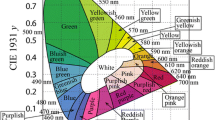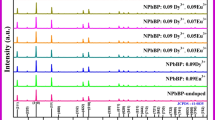Abstract
Eu3+-doped ZnMoO4 with different doping concentrations were synthesized by a hydrothermal method. The effects of Eu3+ doping on the phase structure and photoluminescence (PL) properties of ZnMoO4 were investigated. The result showed that the introduction of Eu3+ could lead to phase transition of ZnMoO4. With the increase of Eu3+ doping amount, β-ZnMoO4 was transformed to α phase gradually, which led to different photoluminescence performances. The optimized doping concentration of Eu3+ was 6 mol% for the highest emission intensity at 615 nm. Its CIE chromaticity coordinates were (0.667, 0.331), which were very close to the values of standard chromaticity (0.67, 0.33) for National Television Standards Committee (NTSC) system. Therefore, Eu3+-doped ZnMoO4 is considered to be a promising red-emitting phosphor for white LED applications.
Similar content being viewed by others
References
Haque M M, Kim D K. Luminescent properties of Eu3+ activated MLa2(MoO4)4 based (M=Ba, Sr and Ca) novel red-emitting phosphors. Mater Lett, 2009, 63: 793–796
Guo C, Luan L, Chen C, et al. Preparation of Y2O2S:Eu3+phosphors by a novel decomposition method. Mater Lett, 2008, 62: 600–602
Hu Y, Zhuang W, Ye H, et al. Preparation and luminescent properties of (Ca1-x,Srx)S:Eu2+ red-emitting phosphor for white LED. J Lumin, 2005, 111: 139–145
Höppe H A, Lutz H, Morys P, et al. Luminescence in Eu2+-doped Ba2Si5N8: Fluorescence, thermoluminescence, and upconversion. J Phys Chem Solids, 2000, 61: 2001–2006
Liu T C, Cheng B M, Hu S F, et al. Highly stable red oxynitride β-SiAlON:Pr3+ phosphor for light-emitting diodes. Chem Mater, 2011, 23: 3698–3705
Kang F, Peng M, Xu S, et al. Broadly tunable emission from CaMoO4:Bi phosphor based on locally modifying the microenvironment around Bi3+ ions. Eur J Inorg Chem, 2014, 2014: 1373–1380
Kang F, Yang X, Peng M, et al. Red photoluminescence from Bi3+and the influence of the oxygen-vacancy perturbation in ScVO4: A combined experimental and theoretical study. J Phys Chem C, 2014, 118: 7515–7522
Kang F, Zhang H, Wondraczek L, et al. Band-gap modulation in single Bi3+-doped yttrium-scandium-niobium vanadates for color tuning over the whole visible spectrum. Chem Mater, 2016, 28: 2692–2703
Kang F, Zhang Y, Wondraczek L, et al. Processing-dependence and the nature of the blue-shift of Bi3+-related photoemission in ScVO4 at elevated temperatures. J Mater Chem C, 2014, 2: 9850–9857
Kang F, Peng M, Zhang Q, et al. Abnormal anti-quenching and controllable multi-transitions of Bi3+luminescence by temperature in a yellow-emitting LuVO4:Bi3+ phosphor for UV-converted white LEDs. Chem Eur J, 2014, 20: 11522–11530
Zhao J, Guo C, Li T, et al. Synthesis, electronic structure and photoluminescence properties of Ba2BiV3O11:Eu3+ red phosphor. Dyes Pigments, 2016, 132: 159–166
Huang L, Zhu Y, Zhang X, et al. HF-free hydrothermal route for synthesis of highly efficient narrow-band red emitting phosphor K2Si1–x F6:xMn4+ for warm white light-emitting diodes. Chem Mater, 2016, 28: 1495–1502
You P. Effect of Tb3+-coped concentration on properties of Li2SrSiO4:Tb3+ phosphor. Adv Mater Res, 2014, 919-921: 2052–2056
Mi R, Zhao C, Xia Z. Synthesis, structure, and tunable luminescence properties of novel Ba3NaLa(PO4)3F:Eu2+,Mn2+ phosphors. J Am Ceram Soc, 2014, 97: 1802–1808
Guo C, Yu J, Ding X, et al. A dual-emission phosphor Li-CaBO3:Ce3+,Mn2+ with energy transfer for near-UV LEDs. J Electrochem Soc, 2011, 158: J42
Zhang J, Gong S, Yu J, et al. Thermally stable white emitting Eu3+ complex@nanozeolite@luminescent glass composite with high CRI for organic-resin-free warm white LEDs. ACS Appl Mater Interfaces, 2017, 9: 7272–7281
Dai P P, Li C, Zhang X T, et al. A single Eu2+-activated high-colorrendering oxychloride white-light phosphor for white-light-emitting diodes. Light Sci Appl, 2016, 5: e16024–16024
Kang F, Zhang Y, Peng M. Controlling the energy transfer via multi luminescent centers to achieve white light/tunable emissions in a single-phased X2-type Y2SiO5:Eu3+,Bi3+ phosphor for ultraviolet converted LEDs. Inorg Chem, 2015, 54: 1462–1473
Guo C, Ding X, Xu Y. Luminescent properties of Eu3+-doped BaLn2ZnO5 (Ln=La, Gd, and Y) phosphors by the sol-gel method. J Am Ceramic Soc, 2010, 93: 1708–1713
Zhou L Y, Wei J S, Gong F Z, et al. A potential red phosphor Zn-MoO4:Eu3+ for light-emitting diode application. J Solid State Chem, 2008, 181: 1337–1341
Mikhailik V B, Kraus H, Wahl D, et al. Optical and luminescence studies of ZnMoO4 using vacuum ultraviolet synchrotron radiation. Nucl Instrum Method Phys Res A, 2006, 562: 513–516
Ivleva L I, Voronina I S, Berezovskaya L Y, et al. Growth and properties of ZnMoO4 single crystals. Crystallogr Rep, 2008, 53: 1087–1090
Spassky D, Vasil’Ev A, Kamenskikh I, et al. Luminescence investigation of zinc molybdate single crystals. Phys Status Solidi A, 2009, 206: 1579–1583
Xei A, Yuan X, Wang F, et al. Enhanced red emission in Zn- MoO4:Eu3+ by charge compensation. J Phys D: Appl Phys, 2010, 43: 55101–55105
Yu L, Nogami M. The synthesis and photoluminescent properties of one-dimensional ZnMoO4:Eu3+ nanocrystals. Mater Lett, 2010, 64: 1644–1646
Reichelt W, Weber T, Söhnel T, et al. Mischkristallbildung im system CuMoO4/ZnMoO4. Z Anorg Allg Chem, 2000, 626: 2020–2027
Söhnel T, Reichelt W, Oppermann H, et al. Zum system Zn/Mo/O.I.Phasenbestand und eigenschaften der ternären zinkmolybdate struktur von Zn3Mo2O9. Z Anorg Allg Chem, 1996, 622: 1274–1280
Pavani K, Ramanan A. Influence of 2-aminopyridine on the formation of molybdates under hydrothermal conditions. Eur J Inorg Chem, 2005, 2005: 3080–3087
Liu B M, Zhang Z G, Zhang K, et al. Unconventional luminescent centers in metastable phases created by topochemical reduction reactions. Angew Chem Int Ed, 2016, 55: 4967–4971
Ju X, Li X, Li W, et al. Luminescence properties of ZnMoO4:Tb3+ green phosphor prepared via co-precipitation. Mater Lett, 2011, 65: 2642–2644
Cavalcante L S, Moraes E, Almeida M A P, et al. A combined theoretical and experimental study of electronic structure and optical properties of β-ZnMoO4 microcrystals. Polyhedron, 2013, 54: 13–25
Keereeta Y, Thongtem T, Thongtem S. Effect of medium solvent ratios on morphologies and optical properties of a-ZnMoO4, ß-ZnMoO4 and ZnMoO4·0.8H2O crystals synthesized by microwave-hydrothermal/ solvothermal method. Superlattice MicroSt, 2014, 69: 253–264
Sun C, Xue D. Crystal growth and design of sapphire: experimental and calculation studies of anisotropic crystal growth upon pulling directions. Cryst Growth Des, 2014, 14: 2282–2287
Sun C, Xue D. Hydrogen bonding nature during ADP crystallization. J Mol Structure, 2014, 1059: 338–342
Liu F, Fang Y, Hou J, et al. Garnet-based red emitting phosphors Li6MLa2Nb2O12: Eu3+ (M=Ca, Sr, Ba): photoluminescence improvement by changing crystal lattice. Ceramics Int, 2014, 40: 3237–3241
Chen L, Liu Y, Li Y. Preparation and characterization of ZrO2:Eu3+ phosphors. J Alloys Compd, 2004, 381: 266–271
Anitha M, Ramakrishnan P, Chatterjee A, et al. Spectral properties and emission efficiencies of GdVO4 phosphors. Appl Phys A, 2002, 74: 153–162
Zhou Y, Xu J, Zhang Z, et al. The spectroscopic properties of Dy3+ and Eu3+ co-doped ZnWO4 phosphors. J Alloys Compd, 2014, 615: 624–628
Li K, Xue D. Estimation of electronegativity values of elements in different valence states. J Phys Chem A, 2006, 110: 11332–11337
Zhang J, Zhao T, Zou L, et al. Ultrasound-assisted precipitation synthesis of PbMoO4 and PbMoO4:Eu3+ nanocrystals and photoluminescence properties. J PhotoChem PhotoBiol A-Chem, 2016, 314: 35–41
Author information
Authors and Affiliations
Corresponding author
Rights and permissions
About this article
Cite this article
Zhou, Y., Zhang, Z., Chu, Y. et al. Phase transition and photoluminescence properties of Eu3+-doped ZnMoO4 red phosphors. Sci. China Technol. Sci. 60, 1473–1479 (2017). https://doi.org/10.1007/s11431-017-9086-1
Received:
Accepted:
Published:
Issue Date:
DOI: https://doi.org/10.1007/s11431-017-9086-1




